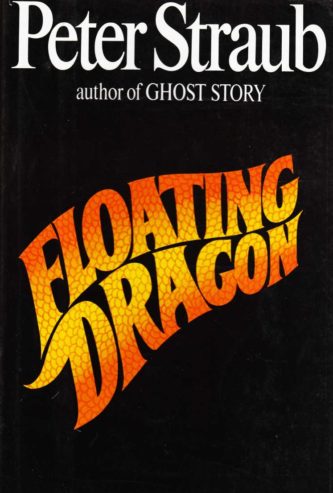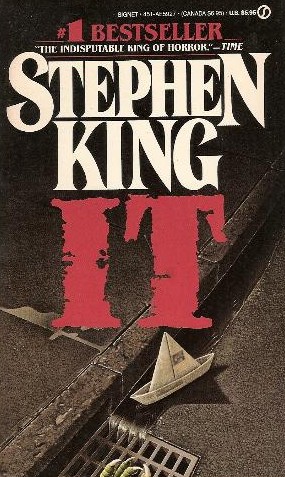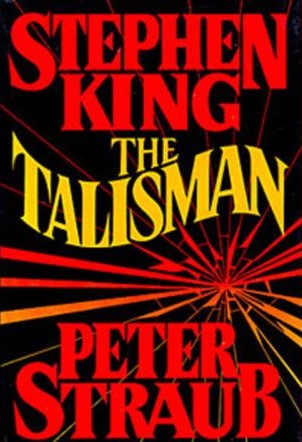 In the introduction to the 1982 hardcover publication of his novella THE GENERAL’S WIFE, Peter Straub states that his 1983 novel FLOATING DRAGON, which at the time was being readied for publication—and from which the text that became THE GENERAL’S WIFE had been excised—could form a “gigantic trilogy” with Stephen King’s IT (an early manuscript of which Straub had perused), and the King-Straub collaboration THE TALISMAN. In the introduction Straub further notes the connections between FLOATING DRAGON and IT, and indeed, the two novels are so similar in conception that if I didn’t know better I’d opine that in IT (which didn’t see publication until 1986) King was ripping off Straub.
In the introduction to the 1982 hardcover publication of his novella THE GENERAL’S WIFE, Peter Straub states that his 1983 novel FLOATING DRAGON, which at the time was being readied for publication—and from which the text that became THE GENERAL’S WIFE had been excised—could form a “gigantic trilogy” with Stephen King’s IT (an early manuscript of which Straub had perused), and the King-Straub collaboration THE TALISMAN. In the introduction Straub further notes the connections between FLOATING DRAGON and IT, and indeed, the two novels are so similar in conception that if I didn’t know better I’d opine that in IT (which didn’t see publication until 1986) King was ripping off Straub.
As for THE GENERAL’S WIFE, it would be impressive if it weren’t so similar to Carlos Fuentes’ AURA. That debt is something Straub is admirably upfront about in the introductory essay under discussion. He’s also quite frank about the travails of drafting FLOATING DRAGON, which Straub admits got out of hand during its inception, and also THE TALISMAN, which in 1982 was still being written.
To my knowledge, aside from Mr. Straub nobody has ever thought to group FLOATING DRAGON, IT and THE TALISMAN together, yet the idea is intriguing enough to at least explore. One thing the three books have in common is the simple fact that they’re long—back in the early eighties it was rare to find a horror novel that exceeded 500 pages (as opposed to a decade later, when it was hard to find a horror book whose page count was under 500), whereas FLOATING DRAGON clocked in at 515 pages in its hardcover edition, THE TALISMAN at 652 pages and IT a whopping 1,138. Beyond that the links between the three, THE TALISMAN in particular, aren’t as evident as Straub claims. 
We’ll start by examining the first of this “trilogy” to be published: Straub’s FLOATING DRAGON. It was intended as a “temporary farewell” to the supernatural fare with which Straub had made his fortune. As he later wrote, “I had decided to take my leave of all this dear, goofy imagery by wrapping it all together (and) blowing it up!” Furthermore, “Anything like restraint or good taste was verboten; the aesthetic was grounded in a single principle, that of excess.” Sounds interesting—more interesting, in fact, than the finished novel, which is definitely excessive (as the late Thomas M. Disch chastised it in a famously withering Twilight Zone magazine review, “Things that go bump in the night are generally scarier than things that go bump bump bump bump bump bump bump bump”), but also exasperating and ultimately unsatisfying.
FLOATING DRAGON is notable for containing not one but two non-human antagonists, both of them too indistinct to make a full impression: a toxic cloud that causes hallucinations and a long-dead personage who used black magic to decimate a New England community 100 years earlier. Now it seems the town is once again threatened by the undead “dragon,” combined with the deadly effects of the cloud. It’s up to a plucky band of townspeople to fight off the evil forces afflicting them, amid a riot of hallucinations, people whose skin liquefies (“leakers”) and other such lunacy.
Aside from utilizing a few too many Stephen King clichés (a psychically endowed teenager in particular), Straub is guilty of impaired judgement. Excess is fine, but passages like the climactic one in which the protagonists engage in a group sing-a-long of “When the Red, Red Robin Comes Bob, Bob, Bobbin’ Along” to defeat the dragon are plain ridiculous (a fact not leavened at all by Straub’s claim that it was supposed to be silly), and accomplish nothing outside of dragging down an already top-heavy narrative.
Excess is also a feature of King’s IT, which was for King what FLOATING DRAGON was for Straub: an extravagant summation of King’s work so far, his self-described “final exam in horror.” It’s a far more successful novel overall, not least because, unlike FLOATING DRAGON, it has a great antagonist: a powerful shape-shifting monstrosity, headlining a narrative that recalls FLOATING DRAGON in many respects, yet has a far more compelling arc.
The setting is a small Maine town in 1958, where a group of outcast youngsters band together to fight the “It” that’s been killing off their friends and relatives. They complete the job, or seem to, but 28 years later It returns, prompting the now-adult protagonists, who’ve forgotten much of what occurred all those years ago, to head back to their hometown to take on the monster a second time.
 The sheer expansiveness of IT’s sprawling canvas leaves ample room for the type of bloat in which King, Mr. “Diarrhea of the Word Processor” himself, specializes. In the same category are the countless freak-out sequences in which the It accosts the protagonists in various guises: a werewolf, giant bird, flying leech and, most prominently, a scary clown named Pennywise. These sequences are all related in a raised voice, and quickly grow tiresome, showcasing some definite conceptual flaws on King’s part.
The sheer expansiveness of IT’s sprawling canvas leaves ample room for the type of bloat in which King, Mr. “Diarrhea of the Word Processor” himself, specializes. In the same category are the countless freak-out sequences in which the It accosts the protagonists in various guises: a werewolf, giant bird, flying leech and, most prominently, a scary clown named Pennywise. These sequences are all related in a raised voice, and quickly grow tiresome, showcasing some definite conceptual flaws on King’s part.
Luckily there’s plenty of authentically good stuff. The characterizations are uniformly strong, with the child protagonists—Bill the stutterer, Ben the fatso, Beverly the tomboy, Mike the token black kid, Stan the neat freak, Richie the incurable wise-ass and the sickly Eddie—all registering as complex, fully-rounded individuals. The adult protagonists are also well drawn, but King’s brilliance is in his spot-on evocation of the world of childhood.
IT definitely outdoes FLOATING DRAGON in excess and bad taste, containing perhaps the most outrageous sequence Stephen King has ever written. I’m referring to the climax, in which the kids descend into the sewers to vanquish It for the first time, an act the 11-year-old Beverly tops off by having sex with her six companions. The author’s reasoning can only be guessed at, but I will say this for the passage: it provides a concluding jolt that the rather disappointing final confrontation, in which the It becomes a big spider, doesn’t.
We’re left with THE TALISMAN, the odd book out. More fantasy than horror oriented, it’s a massive epic that shares with FLOATING DRAGON and IT a tendency toward bloat…though very little else. It was one of my absolute favorite books as a pre-adolescent, when as I recall I read it twice. However, even back then I found much of it overwrought and uneven, and all these years later I find those things bother me still, which among other reasons is why I can’t give THE TALISMAN a full recommendation.
It remains a furiously absorbing and imaginative read nonetheless, with young Jack Sawyer embarking on a marathon walk from New England to California (it’s never satisfactorily explained why he doesn’t fly), dividing his time between our world and an alternate universe called The Territories. He’s in search of the talisman, a magical object which will save the life of his mother, the queen of The Territories. Jack endures all manner of travail, including a sojourn working for an asshole in a greasy spoon diner, a werewolf companion named (appropriately enough) Wolf, torture at the hands of a loony evangelical and his minions, and a climactic showdown in Northern California at the sight of the ominous Black hotel, which houses the Talisman.
The prose is smooth-flowing for the most part, with King and Straub meshing their styles nicely—although Straub shows a marked tendency toward self-plagiarism in a bit where a boarding school is overtaken by a hallucinatory nightmare that seems right out of his novel SHADOWLAND (which is further recalled in the oft-repeated sentence “When we all lived in California and no place else…”). There’s also some genuinely terrible writing, as in the sequence where the evil Morgan Sloat, Richard’s father and Jack’s nemesis, rips his way into the Territories and fires lightning-bolts at Jack, which comes complete with cackling and teeth-bearing. So it’s a flawed—perhaps irredeemably so—book, but an engrossing one nonetheless.
Again, the precise relationship of THE TALISMAN with IT and FLOATING DRAGON remains murky, outside the fact that all three novels are purposefully excessive in their respective construction—and the fact that they happen to have all been written by the same two men. Thus I’ll have to disagree with Straub’s claim that they comprise a trilogy. Yet for those partial to lengthy horror-fantasy epics IT and THE TALISMAN should satisfy, as might FLOATING DRAGON—and I do stress might.
